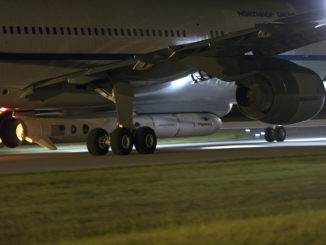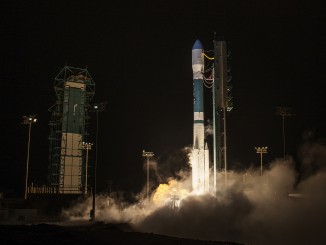NASA officials released never-before-seen views of a spacecraft landing on another planet Monday, showcasing multi-angle replays recorded by ruggedized high-definition cameras mounted on the Perseverance rover last week when it safely touched down on Mars.
The $2.7 billion mission’s entry, descent, and landing cameras recorded video as Perseverance made its way to a landing site in Jezero Crater, a location that was home to a lake of liquid water more than three billion years ago. The imagery brought to life the rover’s high-stakes landing maneuvers, showing the mission’s supersonic parachute blowing open in an instant, followed by separation of the craft’s heat shield, and a final descent powered by eight throttleable rocket engines
Finally, the descent stage rocket pack lowered the one-ton rover to the Martian surface on three nylon bridles. The rocket engines slowed the descent to a crawl in the final seconds before touchdown, whipping up a cloud of dust before the descent stage cut the cords to the nuclear-powered rover and flew a safe distance away to impact the Red Planet.
Matt Wallace, deputy project manager on the Perseverance mission, said ground teams at the Jet Propulsion Laboratory in California were “like kids in a candy store” as images from the entry, descent, and landing, or EDL, cameras streamed back to Earth via an interplanetary radio link over the last few days.
In all, Perseverance’s EDL cameras collected more than 23,000 images — totaling more than 30 gigabytes — for engineers to string together into high-definition video clips, according to Dave Gruel, the mission’s EDL camera lead at JPL.
“I don’t know about you, but it is unlikely at this point in my career that I will pilot a spacecraft down to the surface of Mars, but when you see this imagery, I think you will feel like you are getting a a glimpse of what it would be like to land successfully in Jezero Crater with Perseverance,” Wallace said.
NASA’s Perseverance rover drops to the surface of Mars in this spectacular video from a camera on the mission’s descent rocket pack.
Three nylon cords and an electric umbilical spool out during the “sky crane” maneuver, then they’re cut after landing.https://t.co/vTGniChBuk pic.twitter.com/WKRIbY3Ce6
— Spaceflight Now (@SpaceflightNow) February 23, 2021
NASA’s Perseverance rover drops to the surface of Mars in this spectacular video from a camera on the mission’s descent rocket pack.
Three nylon cords and an electric umbilical spool out during the “sky crane” maneuver, then they’re cut after landing.https://t.co/vTGniChBuk pic.twitter.com/WKRIbY3Ce6
— Spaceflight Now (@SpaceflightNow) February 23, 2021
Perseverance’s landing system, called the “sky crane” by NASA engineers, had the same design that the Curiosity rover used to successfully reach Mars in August 2012. But until now, the system’s designers at JPL had never seen the sky crane at work.
That’s because engineers can’t put the rover landing system through an end-to-end test on Earth. The Martian atmosphere is less than 1 percent the density of Earth’s, and the gravity on Mars is 38 percent that of Earth, meaning NASA could not test the full landing sequence in a Mars-like environment.
Curiosity carried a downward-facing camera that recorded the rover’s descent into Gale Crater, showing the heat shield separation and features on the Martian surface growing larger in the moments before touchdown. But the 2012 landing lacked the resolution and the multitude of views on Perseverance.
“This is the first time we’ve been able to see ourselves, see our spacecraft, land on another planet,” Wallace said.
“Being able to see this system operate like this in high-definition, landing at Jezero, it doesn’t get too much better than that,” Wallace said.

Engineers noticed only a few minor surprises in the video, according to Al Chen, Perseverance’s entry, descent, and landing phase lead.
The parachute lid on top of the spacecraft’s backshell appeared to come off in multiple chunks, rather than in a single piece. One of the chunks appeared to be a radome antenna used to communicate with the spacecraft on the cruise to Mars. Engineers knew that might happen, Chen said.
One of the springs used to push the heat shield off the rover during descent appeared to come loose in flight, Chen said. But the other separation springs worked as expected, and the spacecraft was not endangered, he said.
The spacecraft’s 70.5-foot-wide (21.5-meter) supersonic parachute billowed open in less than a second on the command the rover’s guidance computer, which timed the chute deployment when Perseverance was at predetermined location relative to its landing site. The parachute deployment trigger was a new feature on Perseverance, allowing the mission to target a more precise landing zone than previous Mars probes.
The violent chute deployment shook the spacecraft in the EDL camera views.
“The parachute is packed so densely that the pack is basically the same density as oak, and it’s about 150 pounds,” Chen said. “It gets launched out of the spacecraft with a mortar, which basically a cannon with a muzzle velocity of about 100 mph.”
The shock of the mortar firing knocked one of the mission’s three parachute-pointing EDL cameras offline. The craft’s other five cameras — two pointing at the parachute, one on the descent stage looking down, and two on the rover — all functioned as designed.
“The entry, descent, and landing system behaved as expected, and it did what it had to do,” Chen said. “A big shout out to the terrain relative navigation system, which put us down in the safest spot that was available to us.”
After “textbook” deployment and inflation, the parachute slowed the spacecraft from a velocity nearly twice the speed of sound, setting up for release of the 14.8-foot-diameter (4.5-meter) heat shield, revealing the Martian landscape to a landing radar and cameras to help steer Perseverance toward a safe landing site.
The terrain relative navigation capability used on Perseverance used images from on-board cameras to find a flat, rock-free zone for landing.
The final phase of the landing sequence used eight hydrazine-fueled rocket jets to put the brakes on the rover’s descent. The rocket pack and rover separated from the top part of the spacecraft’s aeroshell, leaving the parachute behind, and ignited the eight thrusters at an altitude of about 1.3 miles, or 2 kilometers.
The descent smoothed out during the final seconds before landing.
Finally, as the descent stage neared the Martian surface, the rover lowered on three nylon cords and configured its six-wheel suspension for contact. The rover fired a pyrotechnic blade to sever the bridles and an electrical umbilical as soon as it sensed it was on the ground, allowing the descent stage to rapidly ascend and divert away from Perseverance.
In seven minutes, the spacecraft braked from a speed of 12,500 mph (20,100 kilometers per hour) to 1.61 mph (2.6 kilometers per hour) at touchdown, according to NASA.

The video shows a cloud of dust kicked up by the landing engines, which produced clear exhaust not visible in the rover’s upward-facing camera view. Hints of a pink glow from the super-hot engines are seen near the thrust chambers, Chen said.
In the end, the rover’s terrain relative navigation system succeeded in choosing a safe landing site, and Perseverance set down just 16 feet, or 5 meters, from the location the spacecraft autonomous selected, according to Chen.
“As a fresh-faced kid when the sky crane was invented, I was in that room, and it’s amazing to see it finally in action,” Chen said. “Even though we knew it worked once, we didn’t know for sure it was going to work again. And for it to work again, for us to see it, is incredible.”
A malfunction prevented a microphone from recording the sounds of the landing. Engineers traced the problem to a communications error in a system that was supposed to digitize the sound recording for storage on the rover’s computer, Gruel said.
Controllers commanded the microphone to switch on again after landing, and the rover sent back an ethereal recording of a wind gust. It is the first recording of a natural sound on another planet.
The EDL microphone, along with a second recording device on one of Perseverance’s science instruments, could record more sounds later in the mission. Wallace hopes to hear the sound of the rover’s titanium-strengthened aluminum wheels crunching over the ground, and the sound of the craft’s drill coring out samples from Martian rocks.
A recording from the Mars microphone is posted here. The sound includes noise from the rover itself.
The Perseverance rover raised its remote sensing mast over the weekend. Two stereo color navigation cameras and the first zoom-capable imager on Mars — called Mastcam-Z — started taking pictures after the deployment of the camera boom.
The cameras began capturing images for a 360-degree panorama to give scientists a view of the rover’s surroundings in Jezero Crater. The data will help mission managers begin planning where Perseverance will drive first.
All of the rover’s science instruments have passed a preliminary health test after landing last week. The Ingenuity helicopter, which will attempt to become the first rotorcraft fly on another planet, is also healthy and undergoing periodic battery charging, said Jessica Samuels, Perseverance’s surface mission manager at JPL.
“The video of Perseverance’s descent and landing, and the amazing panorama, and the first wide landscape shot of Jezero Crater seen with the human eye, and the first Martian sounds are the closest you can get to landing on Mars without putting on a pressure suit,” said Thomas Zurbuchen, associate administrator of NASA’s science mission directorate.
Later this week, control teams at JPL will command Perseverance to switch to a new software program governing the rover’s surface mission. Officials said last week the rover could be ready for its test drive by its eighth or ninth full day on Mars, or as soon as this weekend.
NASA is releasing raw images from Perseverance on a JPL website. As of Monday evening, more than 4,600 images from the spacecraft were uploaded to the site.

One of the first tasks for Perseverance will be the release of the 4-pound (1.8-kilogram) Ingenuity helicopter from its belly pan. After driving a safe distance away, Perseverance will observe a series of helicopter test flights before proceeding with its science mission, which NASA says is expected to last at least two Earth years, or one Martian year.
Perseverance will gather data on the geologic history of Jezero Crater and drive toward a dried-up river delta, where liquid water once flowed into the lake that filled the basin.
Along the way, the rover will collect and seal rock samples in more than 30 cigar-shaped tubes, which the rover will deposit on the Martian surface. A future retrieval mission, set for launch no earlier than 2026, will go to Mars to grab the samples and bring them back to Earth for analysis.
Email the author.
Follow Stephen Clark on Twitter: @StephenClark1.



